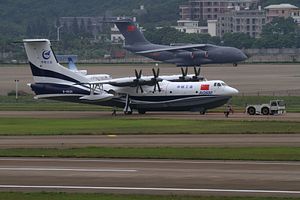China’s indigenously designed and built Jiaolong (Water Dragon) AG600 seaplane took to the skies for the first time on December 24, according to Chinese state media.
The aircraft made its maiden flight, which was broadcast live on Chinese television, from land at Jinwan airport in Zhuhai, Guangdong, China. The flight lasted for about an hour. Following a successful landing, the AG600 taxied to its stand where it was greeted by fanfares and crowds waving Chinese flags.
Earlier this month, the AG600 — believed to be the world’s largest amphibious aircraft — has passed the official technical quality assessment, the last major hurdle before the seaplane’s first flight. The AG600s maiden flight was delayed by a number of months.
As I reported previously, Chinese state-owned aircraft developer Aviation Industry Corporation of China (AVIC) announced in April following the successful completion of a taxiing test that the AG600’s first flight would take place in May followed by a flight on water in the second half of 2017.
The aircraft was rolled out at an AVIC plant in the southern city of Zhuhai in Guangdong province in July 2016.
The AG600s principal missions will be marine search and rescue operations and aerial firefighting. The seaplane can also be used for military operations to support Chinese maritime defense needs including transporting supplies and military personnel to Chinese-controlled islands in the South China Sea (See: “Will this Plane Let China Control the South China Sea?”).
“Assuming, as claimed by the plane’s developers, that the AG600 only requires a water depth of 2.5 meters for landing and take-off, it would be an ideal aircraft to supply some of China’s artificial features in the Spratly Islands given that they are surrounded by shallow waters,” I noted previously.
Furthermore, according to the AG600s chief designer, the aircraft can make round trips without refueling from the southern island province of Hainan to James Shoal, a disputed small bank in the South China Sea administered by Malaysia but claimed by China as its southernmost territory.
In addition, the AG600 can be used for long-range patrols, anti-submarine warfare and mine-laying missions. However, a number of Chinese naval experts have been skeptical about the aircraft’s military utility noting that the aircraft has a number of operational limitations and may not be cost effective.
The technical stats of the AG600 are nevertheless impressive, as I wrote earlier this year:
The Boeing 737-sized AG600 aircraft is 37 meters long and has wingspan of 38.8 meters. Powered by four turboprop WJ-6 engines, the seaplane’s maximum take-off weight is 53.5 tons, its maximum cruising speed 500 kilometers per hour, and the maximum operational range without refueling 4,500 kilometers.
It purportedly can collect 12 tons of water in 20 seconds, and can transport a total of 370 tons of water in a single run.
The Chinese government has already placed an order for 17 AG600 aircraft and is considering purchasing an additional 53 in the coming years. Beijing also hopes to export the aircraft.






























